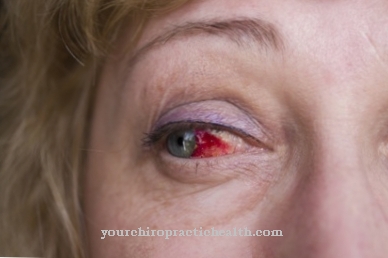Pauses in breathing usually occur as a symptom of so-called sleep apnea at night during sleep. This affects around 2-4 percent of the adult population - especially overweight men who snore noticeably. Breathing pauses lasting several seconds to minutes can lead to an acute lack of oxygen in the organism and, if left untreated, to various chronic complaints in those affected. Special breathing masks can help.
What are breath pauses?

Breathing pauses are short-term interruptions in the involuntary breathing process. They usually occur as part of the sleep apnea syndrome (a-pnoe - Greek: without breath).
The nocturnal pauses in breathing usually last a few seconds, but in extreme cases up to 2 minutes. By definition, sleep apnea syndrome is when at least 5 pauses in breathing lasting 10 seconds or more are recorded per hour.
The cause of the breathing pauses can be a tissue-related occlusion of the trachea or a faulty regulation of the diaphragm muscles as a result of neurological disorders. Involuntary pauses in breathing during the day are very rare. They may refer to asthmatic diseases or occur in the case of mental disorders.
causes
People who suffer from pauses in breathing often have physiological peculiarities in the area of the pharynx-nasal space. Especially men are affected, e.g. generally snore heavily due to a curved nasal septum or voluminous palate tissue.
About 80 percent of apnea sufferers are overweight. A high weight favors an increased accumulation of fatty tissue in the back of the throat and palate. The soft, heavy tissue can then sink slightly, especially in the supine position, during sleep and temporarily block the air supply.
In the event of a threatening drop in the oxygen content in the blood, released stress hormones cause a brief wake-up, which suddenly lets the person concerned take a breath. Breathing pauses occur more frequently after alcohol consumption, as alcohol also relaxes the palate tissue. Neurological disorders that are associated with a regulatory disorder of the respiratory muscles in the chest and abdomen can also be considered as further, albeit rare, causes.
You can find your medication here
➔ Medication for sleep disordersDiseases with this symptom
- Sleep apnea
- Fibromyalgia (fibromyalgia syndrome)
- Obesity
- Nasal septum curvature
- bronchial asthma
- Fatigue syndrome
- allergy
- Alcoholism (alcoholism)
- Frontal sinusitis
Diagnosis & course
Since those affected usually cannot remember the nocturnal pauses in breathing, it is often the partner or family member who first notice the disorder. In apnea patients, very pronounced snoring and several unusually long pauses in breathing are often observed, which are ended by an abrupt startle or noisy breathing.
Those affected themselves suffer from severe daytime sleepiness despite supposedly sufficient sleep time, as waking up several times during the night prevents restful sleep. Based on the descriptions of the partner and the typical symptoms of tiredness of the patient, a medical diagnosis can be made quickly.
First of all, a broad clarification by an ENT, neurologist and oral surgeon makes sense. In order to assess the severity and severity of the breathing pauses, it is also advisable to visit a sleep laboratory. Various parameters such as heart rate, blood oxygen content, brain waves, etc. are precisely analyzed while the patient is sleeping.
If left untreated, the pauses in breathing lead to a chronic sleep deficit over a long period of time. This in turn favors a general reduction in performance and drive. Concentration, memory and possibly also libido disorders occur. The repeated physical alarm conditions can lead to high blood pressure in the long term and increase the risk of heart disease and diabetes.
Complications
Breathing pauses can usually be observed at night, especially in men who snore heavily or are overweight. Breathing pauses can last several seconds, sometimes minutes. This is very dangerous because the organism is no longer adequately supplied with oxygen. Without treatment, pauses in breathing can become life-threatening.
However, if those affected wear special breathing masks, this can be remedied quickly. Breathing pauses occur at night and last for a few seconds. In particularly bad cases, the breath can stand still for up to two minutes. Breathing pauses are rather rare during the day. These patients should go to a sleep laboratory and have the cause of the breathing pauses precisely determined.
Those affected often have physiological peculiarities, for example the pharynx and nasal cavity can be to blame for the breathing pauses, many patients have a curved nasal septum. About 80% of the patients are overweight, which only favors breathing pauses. In the supine position, the tissue can also sink slightly and block the air supply.
If the oxygen content of the blood drops dangerously far, the body releases stress hormones that make the sleeper wake up briefly and gasp for air. This phenomenon is observed particularly frequently after drinking alcohol, as it also relaxes the palate tissue. Neurological disorders are also very rarely considered, they can also cause pauses in breathing.
When should you go to the doctor?
Nocturnal pauses in breathing can be dangerous, so it is necessary to see a doctor early on. When the tongue falls back into the throat while sleeping, the airways become blocked. This can lead to pauses in breathing for seconds, sometimes minutes. The sooner sleep apnea is treated, the better, as it can increase the risk of high blood pressure and type 2 diabetes.
The disease is often treated with a special breathing mask and positive pressure therapy. CPAP therapy creates a standing column of air in the throat, which keeps the upper airways open. Wearing the mask is uncomfortable for many patients, but because the daytime sleepiness is eliminated due to the lack of sleep, it is just as readily accepted as a dry nose and throat. These side effects are far less uncomfortable than the paused breath.
The success rate through the CPAP mask is 95-98%. An anti-snoring device, which also has good success rates, is an alternative therapy. Smokers should stop smoking immediately. Since the sick do not notice much of their breathing pauses, the partners are primarily in demand.
Sleep apnea mainly affects overweight people, but children can get the disease too. Those affected can find the right therapists among ENT doctors and in sleep medicine clinics. There are special sleep laboratories here, where the subjects' sleep rhythm and course of sleep are observed.
Doctors & therapists in your area
Treatment & Therapy
Depending on the underlying cause of the breathing pauses and the findings of the sleep laboratory analysis, different, individually adapted treatment options are available.
Most often, patients are advised to wear a breathing apparatus. With CPAP therapy (Continuous Positive Airway Pressure), the sleeper is ventilated at night with a slight excess pressure, which prevents the trachea from becoming blocked. Pressure and composition of the supplied breathing air, e.g. Additional enrichment with water to prevent the mucous membrane from drying out can be varied individually.
If the breathing pauses are caused by enlarged tonsils and pharynx or nasal polyps, surgical removal may be indicated. Surgical interventions on tongue and palate tissue can also lead to a widening of the pharynx and thus an improved air supply. In the case of jaw misalignments, oral surgery using (bite) splints, braces or operations alleviate breathing difficulties.
In milder cases, simple measures to prevent a supine position during sleep may be sufficient. These can be devices worn at night that send out alarm signals if the sleeping position is unfavorable. A self-implementable countermeasure can e.g. E.g. sewing annoying, but not injurious, objects (e.g. tennis balls) into the back of pajamas.
Outlook & forecast
The consequences of nocturnal pauses in breathing are more far-reaching than the resulting tiredness and difficulty concentrating. Exhaustion caused microsleep at the wheel can lead to life-threatening accidents.
The reduced quality of sleep has a negative effect on the regeneration of the entire organism and in the long term represents a heavy burden on the body. If left untreated, pauses in breathing can be a trigger for many secondary diseases. The oxygen supply to the brain is interrupted by the breathing pauses.To compensate for this lack of oxygen, the heart rate is increased, which can lead to irregular heartbeats and high blood pressure. Those affected also have an increased risk of suffering a heart attack or stroke.
In general, patients with untreated pauses in breathing have a life expectancy that is ten years shorter than that of healthy people. Timely treatment is therefore crucial for a good prognosis and can greatly reduce the risks.
With a CPAP ventilation therapy, which has a success rate of 98%, the quality of sleep can be significantly improved. It can be difficult to get used to the respiratory mask, but in most cases you will soon improve afterwards. The patients are more productive and blood pressure can also be reduced through ventilation.
You can find your medication here
➔ Medication for sleep disordersprevention
The common treatment measures against breathing pauses - such as wearing special breathing equipment - are also based on the principle of prevention. Those affected can also take action themselves in order to positively influence the course of the breathing disorder.
In general, reducing excessive weight is recommended. Refraining from alcohol and cigarettes also has a beneficial effect on healthy sleep and prevents excessive slackening of the palate tissue. These stimulants should be avoided, especially late in the evening, in order to prevent breathing pauses at night.
You can do that yourself
Nocturnal pauses in breathing, so-called sleep apnea, are dangerous because they double the risk of stroke. Basically, the ENT doctor is the right contact for treating paused breathing. A sleep mask is usually prescribed, but patients can take preventive action.
Those who eliminate the causes of sleep apnea may soon be able to look forward to continuous phases of sleep. Typical risk factors for pauses in breathing are stress, obesity and smoking. Quitting smoking increases the likelihood of restful sleep and increases your life expectancy. Reducing obesity often leads to success and also prevents cardiovascular diseases. If a slight misalignment of the jaw is the cause of snoring, a splint can help. This is only worn at night. Incorrectly dosed sleeping pills and sedatives can lead to paralysis of the throat muscles and trigger breathing pauses. The less sleeping pills you take, the better your health. Alcohol also has a slight paralysis effect. Those who do without it in the evening sleep more calmly and deeply.
Sometimes a new pillow helps, because a down pillow that the patient with sleep apnea sinks into is not helpful. The exact reasons for insomnia can be found out in the sleep laboratory. In a self-help group, those affected and their relatives receive valuable tips and moral support. This supports them in coping with the disease.



























